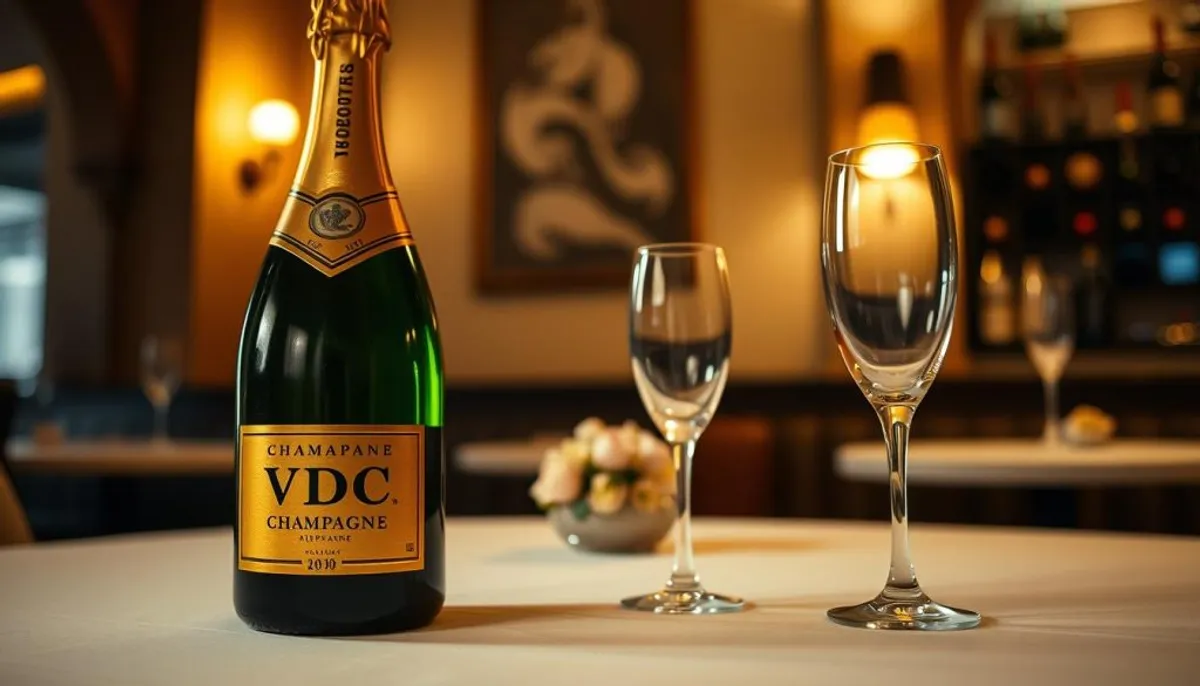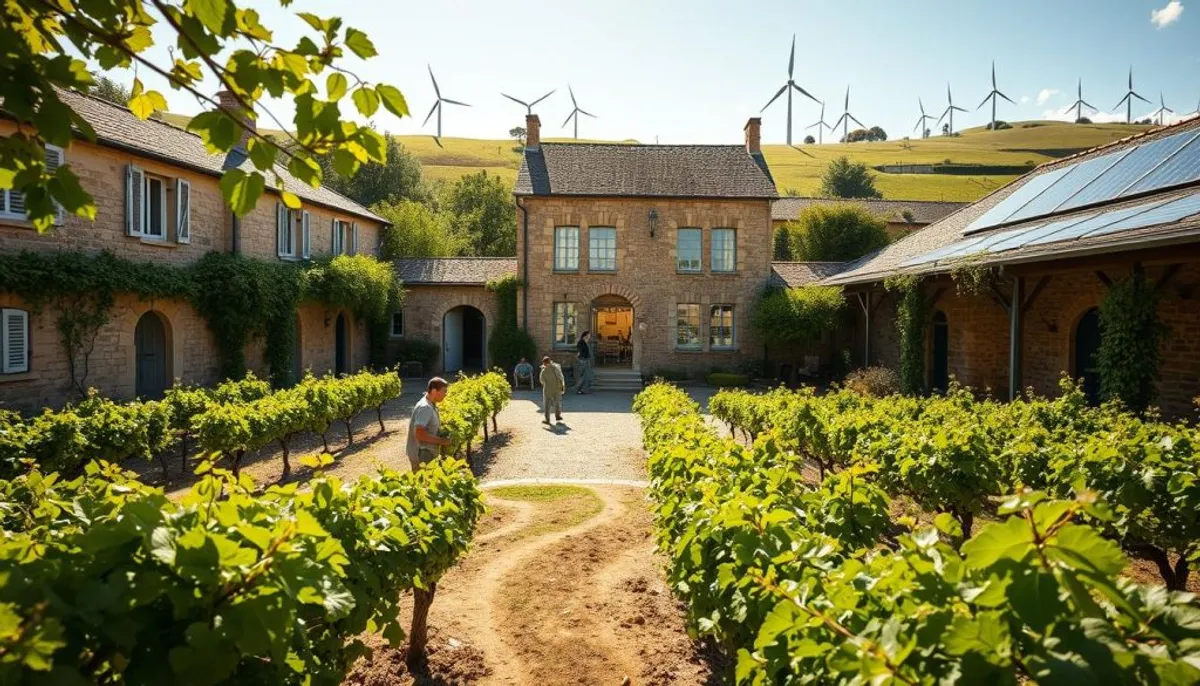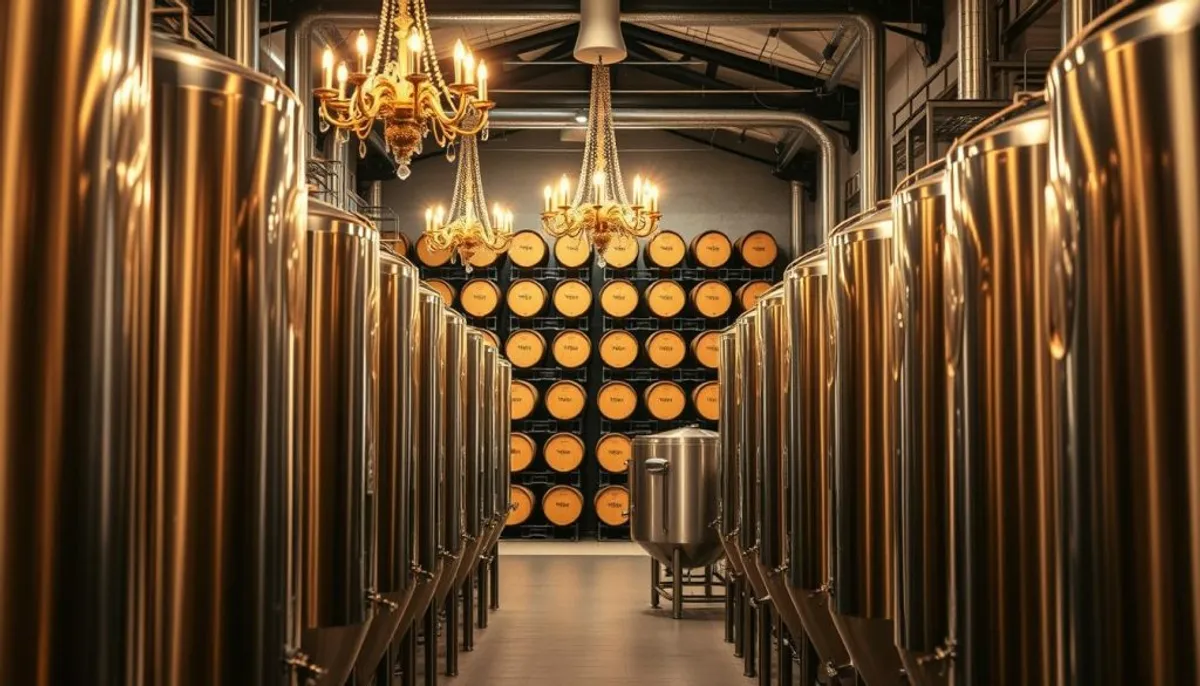The realm of luxury champagne is undergoing a transformation, with VDC (Viticulture Durable en Champagne) certified wines at the forefront. These wines, renowned for their elegance and celebratory nature, now also embody sustainability. This shift marks a significant milestone in the industry.
VDC champagne heralds a new chapter in the Champagne region’s illustrious history. These luxury French champagnes are crafted with a commitment to environmental stewardship, ensuring quality is not compromised. The VDC certification guarantees that each bottle adheres to stringent sustainable production standards.

For champagne aficionados globally, VDC certified bottles offer a guilt-free pleasure. These exquisite French champagnes, available for export, introduce sustainable luxury to connoisseurs worldwide. The emergence of VDC champagne and champagne lamotte signifies a pivotal moment, demonstrating that eco-awareness and high-quality can coexist harmoniously.
Key Takeaways
- VDC certification represents sustainable practices in champagne production
- Luxury French champagne is embracing environmental responsibility
- VDC certified champagnes are available for worldwide export
- The Champagne region has reduced carbon emissions by 20% since 2000
- 15% of Champagne’s vineyard area is currently VDC certified
- Organic farming in Champagne has grown from 64 hectares in 2000 to 2,751 hectares in 2021
The Evolution of Sustainable Champagne Production
The transformation of sustainable champagne production spans nearly five decades. Premium champagne brands have been pivotal, transitioning from chemical-intensive to eco-conscious methods. This shift reflects a broader commitment to environmental stewardship.
Historical Perspective: 1970s to 2000
The period from the 1970s to 2000 was marked by significant challenges in champagne production. The overuse of chemicals led to soil degradation and the abandonment of traditional practices. Yields skyrocketed, reaching up to 250 hectoliters per hectare by 2018. This era prioritized quantity over quality, affecting many champagne brands.
Environmental Initiatives and Improvements
The millennium ushered in a new era of change. The Comité Champagne, representing 15,000 winemakers and 300 champagne houses, led sustainability efforts. They initiated a carbon footprint assessment in 2003, laying the groundwork for future enhancements. Premium champagne producers then adopted eco-friendly practices, notably reducing nitrogen fertilizer use by 50% in the first 15 years of the 21st century. Additionally, for those interested in preserving the quality of their bubbly, following champagne storage tips can greatly enhance the enjoyment of this fine beverage.
Modern Sustainable Practices
Today, champagne brands are leaders in sustainable viticulture. The region aims to eliminate herbicides by 2025, with 20% of vineyards already certified. Organic farming is expanding, with over 700 hectares certified. Louis Roederer, among others, is at the forefront, owning a significant portion of the region’s organic vineyards. The industry has set ambitious targets, including 100% environmental certification by 2030 and a 75% reduction in carbon footprint by 2050.
Understanding VDC Champagne Certification
The Viticulture Durable en Champagne (VDC) certification is revolutionizing the champagne industry. Introduced in 2014, it aims to promote environmentally friendly practices among champagne houses. This certification is pivotal in shaping the industry’s future.
Definition and Requirements
VDC certification demands high standards from champagne producers. It mandates adherence to 60 critical standards, 31 major standards, and 20 minor standards. These standards encompass biodiversity, water management, and soil health. Prestigious champagne houses, such as Veuve Clicquot, are embracing these practices to meet VDC requirements, including the innovative use of capsule champagne jl to enhance sustainability efforts.
Environmental Impact Reduction
VDC certification aims to minimize the environmental footprint of champagne production. It restricts pesticide use, conserves water, and protects local ecosystems. Champagne houses are adopting measures like planting hedges and wildflowers to enhance biodiversity. Some are even installing bird nesting boxes to support local wildlife. Additionally, the use of capsule champagne lb has become a part of sustainable practices to ensure quality and reduce waste.
Certification Process
The VDC certification process is thorough and spans about three years. Champagne houses must prove their commitment to sustainable practices during this time. The certification is reviewed every 18 months to ensure ongoing compliance. Currently, 15% of the Champagne region’s vineyard area is VDC certified, with a goal to reach 100% by 2030.
As consumers increasingly prioritize environmental concerns, supporting VDC-certified champagne houses can significantly influence the industry’s sustainability efforts. This transition towards sustainable practices is redefining the future of luxury champagne production.
Premier Champagne Houses Embracing Sustainability
Famous champagne houses are pioneering sustainable practices. Maison Cattier, with its 400-year legacy, leads this charge. The Cattier family, guiding this heritage for thirteen generations, has transformed their 33-hectare vineyard into an environmental model.

Cattier’s commitment to sustainability began in the mid-1990s. Their efforts have garnered prestigious certifications, including High Environmental Value (HVE) level 3 and Sustainable Viticulture in Champagne (VDC). These achievements highlight their commitment to environmental stewardship while preserving champagne quality.
Other esteemed champagne houses are also embracing sustainability. Besserat de Bellefon, Canard-Duchêne, Drappier, Joseph Perrier, and Lanson have started organic cultivation in parts of their vineyards. This widespread adoption underscores the luxury champagne industry’s growing awareness of sustainable practices.
Maison Cattier’s champagne-making embodies a harmonious blend of tradition and sustainability. Their cellars, among the deepest in Champagne, house up to 2 million bottles. The Brut Premier Cru ages for over 4 years, while prestige vintages mature for more than 8 years. This extended aging, combined with sustainable methods, creates champagne that respects both the environment and the connoisseur’s palate.
Organic Farming in Champagne Region
The Champagne region has witnessed a notable transition towards organic farming in recent years. This shift underscores a deepening dedication to sustainable viticulture among esteemed champagne brands and producers of vintage champagne. Among these, the quest for the champagne ngon nhất is becoming increasingly prominent as consumers seek the finest quality in sustainability.
Growth of Organic Vineyards
The expansion of organic farming in Champagne has been nothing short of remarkable. In 2000, only 64 hectares were dedicated to organic viticulture. By 2021, this area had expanded to 2,751 hectares, with an additional 1,790 hectares in the conversion process. This growth represents about 8% of Champagne’s total vineyard area, highlighting a robust trend towards sustainable practices.
Leading Organic Producers
Louis Roederer emerges as a trailblazer in organic viticulture, boasting 115 hectares of certified organic vineyards. This constitutes nearly 50% of their holdings and 12% of Champagne’s total certified organic vineyards. The number of domaines embracing organic methods has surged to 598, indicating a widespread adoption across the region.
Certification Standards
Organic certification in Champagne demands strict adherence to specific standards. Producers must eschew chemical pesticides, herbicides, fungicides, and fertilizers for at least three years. While organic fertilizers and certain pesticides like copper sulfate are allowed, the certification process is costly. This has prompted some winemakers to practice organic farming without official certification.
The transition towards organic farming in Champagne symbolizes a broader commitment to environmental stewardship among vintage champagne producers. As more champagne brands adopt these practices, consumers can anticipate an expanding array of high-quality, sustainably produced sparkling wines from this renowned region.
Biodynamic Practices in French Champagne
The evolution of French champagne production is marked by the increasing adoption of biodynamic practices. These methods transcend organic farming, viewing vineyards as integral ecosystems. Notably, the emmanuel brochet winery was a pioneer in this field, setting a precedent for other luxury champagne producers.
Biodynamic vineyards adhere to a lunar calendar and employ natural preparations to enhance soil vitality. This approach seeks to produce wines that authentically reflect their terroir. Renowned biodynamic producers include André Beaufort, Vincent Couche, and Vouette & Sorbée.
The trend towards biodynamics is part of a broader sustainability movement in Champagne. Currently, over 8% of the region’s vineyards hold organic certification, a figure dwarfed by the 20% across France. This growth, though promising, faces hurdles, notably the disease pressures of the 2021 rainy season.
Biodynamic luxury champagne is increasingly sought after by connoisseurs. These wines often exhibit distinctive traits, a testament to the meticulous attention given to the vines. As more producers embrace these practices, the French champagne landscape continues to transform, offering wine enthusiasts novel experiences.
Top VDC Champagne Producers and Their Signature Cuvées
The realm of VDC champagne is teeming with premier producers, each dedicated to crafting premium champagnes through sustainable methods. Among these innovations is the capsule champagne jl, which represents a fusion of tradition and modernity. These establishments merge ancient traditions with modern innovations, resulting in cuvées that delight the senses while upholding environmental stewardship.
Notable Houses and Estates
Champagne Henriot emerges as a paragon of sustainability within the industry. Established in 1808, this esteemed house recently garnered the 2024 Sparkling Wine Producer Trophy at the IWSC. Henriot’s unwavering commitment to eco-friendly practices is underscored by their attainment of full HVE and VDC certification in 2024.
Veuve Clicquot, a quintessential name in the realm of premium champagne, has also embraced VDC principles. Their dedication to sustainable viticulture is evident in their signature cuvées, which harmoniously blend luxury with environmental responsibility, making them perfect for celebratory drinks.
Exceptional Vintages
Alexandre Bonnet, spanning 47 hectares, produces remarkable VDC champagnes. Their vineyard, predominantly Pinot Noir, yields six distinct cuvées. The estate’s commitment to sustainability is evident in their organic conversion efforts and low-yield vinification process.

Tasting Notes and Ratings
Alexandre Bonnet’s Blanc de Noirs Extra Brut exemplifies the pinnacle of VDC champagne quality, earning 93 points for its intricate aroma profile. Their Les Contrées Rosé Extra Brut 2019, a unique Rosé de Saignée, garnered a stellar 94-point rating, highlighting the diversity and excellence achievable through sustainable practices.
| Cuvée | Producer | Composition | Rating |
|---|---|---|---|
| Blanc de Blancs Extra Brut | Alexandre Bonnet | 50% Pinot Blanc, 50% Chardonnay | Not Rated |
| Rosé Extra Brut | Alexandre Bonnet | 100% Pinot Noir | Not Rated |
| Blanc de Noirs Extra Brut | Alexandre Bonnet | 100% Pinot Noir | 93 points |
| Les Contrées 7 Cépages Extra Brut 2019 | Alexandre Bonnet | Blend of 7 grape varieties | 92 points |
| Les Contrées Rosé Extra Brut 2019 | Alexandre Bonnet | 100% Pinot Noir (Rosé de Saignée) | 94 points |
Terroir and Regional Influences
The Champagne region’s unique terroir is pivotal in shaping French champagne’s character. This area, rich with diverse soil compositions and microclimates, influences the distinct flavor profiles of its sparkling wines. It is a treasure trove for champagne houses, each contributing to the region’s international acclaim.
The landscape is adorned with landmarks like the Notre-Dame de Reims Cathedral and the Verzenay Lighthouse. The village of Hautvillers adds to its charm. Yet, it’s the vineyards and prestigious champagne houses that truly define its international reputation.
Many estates in Champagne are embracing sustainable practices. They hold certifications like “Viticulture Durable en Champagne” (VDC) and “Haute Valeur Environnementale” (HVE). These efforts reflect a growing commitment to preserving the region’s unique terroir while producing exceptional wines.
Some champagne houses, including the emmanuel brochet winery, focus on single-village and single-vintage productions. They emphasize the importance of terroir expression. By cultivating grapes from specific plots and creating monovarietal champagnes, these producers showcase the nuanced influences of their land.
The emphasis on quality over quantity is evident in selective harvesting practices. A dedication to creating wines with “beautiful aromatic presence” is evident. This approach allows champagne houses to fully capture the essence of their terroir in each bottle of French champagne.
The Art of Champagne Blending
Champagne blending is a critical step in crafting the unique flavors of renowned champagne brands. This intricate process marries tradition with innovation, yielding the distinctive styles that champagne aficionados adore.
Traditional Methods
For centuries, champagne houses have employed blending to ensure consistency. Non-vintage champagnes typically blend reserve wines with the current harvest. For instance, Ruinart’s Blanc Singulier cuvée combines 80% wine from the 2018 vintage with 20% reserve wine. This method guarantees a balanced flavor profile each year.
Modern Innovations
Contemporary champagne brands are venturing into novel blending techniques. Roederer’s Collection 244, for example, incorporates over 50% vintage wine, one-third from a perpetual cuvée, and the remainder from reserve wines. This modern strategy crafts complex flavors while respecting traditional methods.
House Styles
Each champagne house boasts its distinct style. Krug’s Grande Cuvée, a non-vintage prestige cuvée, blends 131 wines from 12 different years. Henriot’s Cuve 38, on the other hand, contains wines from over 30 vintages, with only 1,000 magnums released since 2007. These diverse approaches highlight the artistry behind famous champagne production.
| Champagne House | Blend Composition | Unique Feature |
|---|---|---|
| Ruinart | 80% 2018 vintage, 20% reserve wine | Brut nature style |
| Roederer | 50% vintage, 33% perpetual cuvée, 17% reserve | Modern blending approach |
| Krug | 131 wines from 12 years | 7-year aging period |
| Henriot | Wines from 30+ vintages | Limited release of 1,000 magnums |
Conclusion: The Future of Luxury Sustainable Champagne
The realm of luxury champagne is undergoing a transformation, with VDC champagne at the forefront of this shift towards sustainability. Piper-Heidsieck, a trailblazer in this field, achieved B Corp certification in 2022, marking a historic milestone. This achievement underscores their dedication to environmental stewardship, as evidenced by their dual VDC and HVE certifications since 2015. For those seeking the champagne ngon nhất, this commitment to quality and sustainability is paramount.
The horizon for luxury champagne appears promising, with a growing emphasis on eco-friendliness. Currently, 1,790 hectares of vineyards are undergoing conversion, signaling an imminent increase in organic Champagnes. This transition is not merely about environmental concerns; it also ensures the preservation of the high standards that luxury champagne aficionados cherish.
Looking forward, the fusion of tradition and innovation in VDC champagne production heralds a new era of excellence for champagne enthusiasts globally. Piper-Heidsieck’s accolades and Ruinart’s groundbreaking packaging, which slashes carbon footprint by 60%, exemplify the industry’s commitment to sustainability. These efforts do not come at the expense of taste or sophistication, setting a new benchmark for luxury champagne.
Are you prepared to embark on a journey through the realm of sustainable luxury champagne? Visit https://champagne-export.com to request a personalized quote today. Join the movement towards a champagne experience that is both indulgent and environmentally conscious.
RelatedRelated articles



